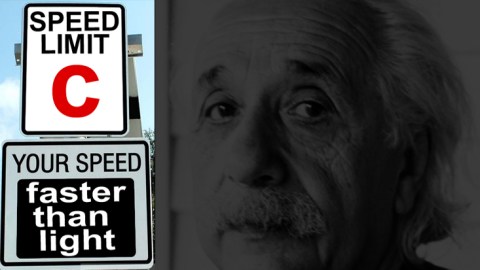Breaking the Speed of Light and Contemplating the Demise of Relativity

Einstein released many theories during his scientific career, but it was the publishing of his two theories of relativity that literally shook the foundations of physics. The theories proposed by Einstein still stand today even though there are many individuals who have tried to challenge them. In 1905, Einstein published his special theory of relativity and he later followed that with the general theory of relativity in 1915. Each of these theories are comprised of their own sets of equations, laws and principles that explain why things act the way they do, from the largest of galaxies to the smallest of particles.
Einstein was in his mid-20’s when he published his special theory of relativity, which became an absolutely essential tool for scientists, physicists, theorists and experimentalists around the world today. Some of the concepts that were introduced were time dilation, length contraction, and his famed theory of mass-energy equivalence with the introduction of E = mc2. One of Einstein’s other concepts, and the subject of this blog entry, was Einstein’s introduction of the cosmic speed limit which states that no physical object or information can travel faster than the speed of light in a vacuum.
Shortly after the publishing of his special theory of relativity, Einstein immediately began working out equations that encompassed geometric views of gravitation and introduced new and exciting concepts that replaced Newtonian mechanics, which had lasted 250 years. Scientists had been able to calculate low energy effects of gravity for centuries with Newton’s theory, but until Einstein, what actually caused gravity had remained a mystery. Einstein’s general theory showed the world that gravity was caused by the bending of space and time. So in short, it’s not a gravitational force that is holding us all firmly down to the ground but it’s space that is actually pushing you down. The theory explained such phenomenon as the bending of light by gravity and opened up the entirely new field of cosmology. The theory also made entirely new predictions, such as the Big Bang theory and also black holes, which continue to be a rich area of research for scientists.
Needless to say, Einstein’s theory has withstood the test of time for almost a century and if there’s one data-point out of place, we would have to throw the entire theory out. So everywhere we look into the heavens, Einstein’s theory of general relativity comes right on the spot.
Last week, an international team of researchers and scientists reported that they have recorded sub-atomic particles appearing to travel faster than the speed of light. Over a period of three years, neutrinos were shot from the particle accelerator at CERN in Switzerland to a detector in Italy (the OPERA – Oscillation Project with Emulsion Tracking Apparatus) about 500 miles away. What the team found interesting was that the neutrinos arrived around 60 nanoseconds quicker than the light would have traveled. This recent result from the accelerator at CERN, which seems to contradict Einstein’s theory of relativity, has generated enormous interest, among scientists as well as the public. However, not much has been written about precisely what this means for relativity itself.
Special Relativity of 1905, as discussed above, is based on the idea that the speed of light is the same, no matter who measures it, as long as you move smoothly and do not accelerate. This violates Newton’s common sense notion that there is nothing special about the speed of light. Hence, something has got to give. So, our common sense notion of the universe must change if light speed is the same no matter how we measure it, whether it is coming toward us, away from us, or sideways. What gives is space-time. Hence:
All of the effects above have been observed. For example, our GPS satellites slow down a bit as they whiz overhead, just as Einstein predicted. There is also cosmic waves and particle accelerators that are also used to verify this fact.
If you get heavier the faster you move, then the energy of motion has turned into mass. The precise amount of kinetic energy that turns into mass is easily calculated using relativity (the derivation is 1 line long) and that result is the most celebrated equation in science, E = mc2.
So why is light speed the maximum speed in the universe? As you approach the speed of light, bizarre things begin to happen such as:
If you exceed the speed of light, then you get nonsense such as:
For these reasons, Einstein stated that you cannot go faster than the speed of light. This also affects general relativity, which is the foundation of cosmology, since (for small distances) general relativity reduces down to special relativity. Hence, both are wrong if the recent CERN experiments are correct. Not only is cosmology, nuclear physics, atomic physics, laser physics, etc. all in doubt, but also the fundamental theories of particle physics are also thrown in doubt. The Standard Model of particle physics (containing quarks, electrons, neutrinos, etc). is also based on relativity and would also mean that string theory, my field, may also be wrong. String theory has relativity built-in from the start and the lowest octave of string contains the entire general theory of relativity.
So you can see why physicists are breaking out in a cold sweat contemplating the demise of relativity. Not only will all textbooks have to rewritten but we will also have to recalibrate all our physics calculations, not to mention all of our theories of both nuclear, atomic physics and cosmology. What a headache! So, I think most physicists are holding their breath, wishing that the recent CERN experiment is shown to be flawed and something of a false alarm. However, there is the slim chance that the result holds up. Then relativity may fall and we will have to await the coming of the next Einstein who can make sense out of it all — In retrospect however, This is How Science is Done.





